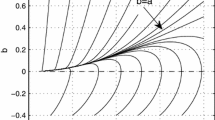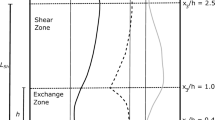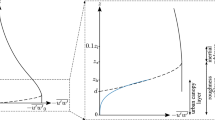Abstract
An extended Lagrangian stochastic dispersion model that includes time variations of the turbulent kinetic energy dissipation rate is proposed. The instantaneous dissipation rate is described by a log-normal distribution to account for rare and intense bursts of dissipation occurring over short durations. This behaviour of the instantaneous dissipation rate is consistent with field measurements inside a pine forest and with published dissipation rate measurements in the atmospheric surface layer. The extended model is also shown to satisfy the well-mixed condition even for the highly inhomogeneous case of canopy flow. Application of this model to atmospheric boundary-layer and canopy flows reveals two types of motion that cannot be predicted by conventional dispersion models: a strong sweeping motion of particles towards the ground, and strong intermittent ejections of particles from the surface or canopy layer, which allows these particles to escape low-velocity regions to a high-velocity zone in the free air above. This ejective phenomenon increases the probability of marked fluid particles to reach far regions, creating a heavy tail in the mean concentration far from the scalar source.







Similar content being viewed by others
References
Anand M, Pope S, Mongia H (1993) Pdf calculations for swirling flows. In: Proceedings of 31st aerospace sciences meeting and exhibition, Reno, NV. AIAA Paper 93–0106
Antonia R (1973) Some small scale properties of boundary layer turbulence. Phys Fluids 16:1198–1206
Baldocchi D (1997) Flux footprints within and over forest canopies. Boundary-Layer Meteorol 85(2):273–292
Cassiani M, Franzese P, Giostra U (2005a) A PDF micromixing model of dispersion for atmospheric flow. Part I: development of the model, application to homogeneous turbulence and to neutral boundary layer. Atmos Environ 39(8):1457–1469
Cassiani M, Radicchi A, Giostra U (2005b) Probability density function modelling of concentration fluctuation in and above a canopy layer. Agric For Meteorol 133:153–165
Chen W (1971) Lognormality of small-scale structure of turbulence. Phys Fluids 14:1639–1642
Finnigan J (2000) Turbulence in plant canopies. Annu Rev Fluid Mech 32:519–571
Flesch T, Wilson J (1992) A two-dimensional trajectory-simulation model for non-Gaussian, inhomogeneous turbulence within plant canopies. Boundary-Layer Meteorol 61:349–374
Flesch TK, Wilson JD, Yee E (1995) Backward-time Lagrangian stochastic dispersion models and their application to estimate gaseous emissions. J Appl Meteorol 34(6):1320–1332
Freytag C (1978) Statistical properties of energy dissipation. Boundary-Layer Meteorol 14(2):183–198
Frisch U (1996) Turbulence: the legacy of A. N. Kolmogorov. Cambridge University Press, Cambridge, 296 pp
Hsieh C, Katu G, Chi T (2000) An approximate analytical model for footprint estimation of scalar fluxes in thermally stratified atmospheric flows. Adv Water Resour 23(7):765–772
Hsieh CI, Katul G (2009) The Lagrangian stochastic model for estimating footprint and water vapor fluxes over inhomogeneous surfaces. Int J Bioclimatol Biometeorol 53(1):87–100
Juang J, Katul G, Siqueira M, Stoy P, Palmroth S, McCarthy HR, Kim H, Oren R (2006) Modeling nighttime ecosystem respiration from measured \(\text{ CO }_2\) concentration and air temperature profiles using inverse methods. J Geophys Res 111:D08S05
Juang J, Katul G, Siqueira M, McCarthy H (2008) Investigating a hierarchy of eulerian closure models for scalar transfer inside forested canopies. Boundary-Layer Meteorol 128:1–32
Kaimal J, Finnigan J (1994) Atmospheric boundary layer flows: their structure and measurement. Oxford University Press, New York, 289 pp
Katul G, Albertson J (1998) An investigation of higher-order closure models for a forested canopy. Boundary-Layer Meteorol 89(1):47–74
Kljun N, Rotach N, Schmid H (2002) A three-dimensional backward Lagrangian footprint model for a wide range of boundary-layer stratifications. Boundary-Layer Meteorol 103:205–226
Kolmogorov A (1962) A refinement of previous hypotheses concerning the local structure of turbulence in a viscous incompressible fluid at high Reynolds number. J Fluid Mech 13:82–85
Kurbanmuradov O, Sabelfeld K (2000) Lagrangian stochastic models for turbulent dispersion in the atmospheric boundary layer. Boundary-Layer Meteorol 97(2):191–218
Leuning R, Denmead O, Miyata A, Kim J (2000) Source/sink distributions of heat, water vapor, carbon dioxide, and methane in a rice canopy estimated using lagrangian dispersion analysis. Agric For Meteorol 103:233–249
Li P, Taylor P (2005) Three-dimensional Lagrangian simulation of suspended particles in the neutrally stratified atmospheric surface layer. Boundary-Layer Meteorol 116(2):301–311
Minier J, Pozorski J (1999) Wall-boundary conditions in probability density function methods and application to a turbulent channel flow. Phys Fluids 11:2632–2644
Monin A, Yanglom A (1975) Statistical fluid mechanics: mechanics of turbulence, vol 2. MIT Press, Cambridge, 874 pp
Nathan R, Katul G, Horn H, Thomas S, Oren R, Avissar R, Pacala S, Levin S (2002) Mechanisms of long-distance dispersal of seeds by wind. Nature 418(6896):409–413
Nemitz E, Sutton M, Gut A, San-José R, Husted S, Schjoerring J (2000) Sources and sinks of ammonia within an oilseed rape canopy. Agric For Meteorol 105:385–404
Novikov E (1969) Relation between the Lagrangian and Eulerian descriptions of turbulence. J Appl Math Mech 33(5):862–864
Novikov E (1986) The Lagrangian–Eulerian probability relations and the random force method for nonhomogeneous turbulence. Phys Fluids 29(12):3907–3909
Obukhov A (1962) Some specific features of atmospheric turbulence. J Geophys Res 67:3011–3014
Poggi D, Katul G, Albertson J (2004) Momentum transfer and turbulent kinetic energy budgets within a dense model canopy. Boundary-Layer Meteorol 111:589–614
Poggi D, Katul G, Albertson J (2006) Scalar dispersion within a model canopy: measurements and three-dimensional Lagrangian models. Adv Water Resourc 29(2):326–335
Pope S (1991) Application of the velocity–dissipation probability density function model to inhomogeneous turbulent flows. Phys Fluids A 3:1947–1957
Pope S (2000) Turbulent flows. Cambridge University Press, Cambridge, 771 pp
Pope S, Chen Y (1990) The velocity–dissipation probability density function model for turbulent flows. Phys Fluids A 2:1437–1449
Porta AL, Voth GA, Crawford AM, Alexander J, Bodenschatz E (2001) Fluid particle accelerations in fully developed turbulence. Boundary-Layer Meteorol 409:1017–1019
Rannik Ü, Aubinet M, Kurbanmuradov O, Sabelfeld K, Markkanen T, Vesala T (2000) Footprint analysis for measurements over a heterogeneous forest. Boundary-Layer Meteorol 97(1):137–166
Raupach M (1989) Applying Lagrangian fluid-mechanics to infer scalar source distributions from concentration profiles in plant canopies. Agric For Meteorol 47:85–108
Raupach M, Thom A (1981) Turbulence in and above plant canopies. Annu Rev Fluid Mech 13:97–129
Rodean H (1996) Stochastic Lagrangian models of turbulent diffusion. Meteorological monographs, vol 26, no. 48. American Meteorological Society, Boston, 84 pp
Simon E, Lehmann B, Ammann C, Ganzeveld L, Rummel U, Meixner F, Nobre A, Araujo A, Kesselmeier J (2005) Lagrangian dispersion of \(^{222}\)Rn, \(\text{ H }_2\)O and \(\text{ CO }_2\) within Amazonian rain forest. Agric For Meteorol 132:286–304
Siqueira M, Lai C, Katul G (2000) Estimating scalar sources, sinks, and fluxes in a forest canopy using Lagrangian, Eulerian, and hybrid inverse models. J Geophys Res 105:29475–29488
Siqueira M, Katul G, Lai C (2002) Quantifying net ecosystem exchange by multilevel ecophysiological and turbulent transport models. Adv Water Resour 25:1357–1366
Siqueira M, Leuning R, Kolle O, Kelliher F, Katul G (2003) Modeling sources and sinks of \(\text{ CO }_2, \text{ H }_2\)O and heat within a Siberian pine forest using three inverse methods. Q J R Meteorol Soc 129:1373–1393
Siqueira M, Katul G, Tanny J (2012) The effect of the screen on the mass, momentum, and energy exchange rates of a uniform crop situated in an extensive screenhouse. Boundary-Layer Meteorol 142(3):339–363
Taylor G (1921) Diffusion by continuous movements. Proc Lond Math Soc 20:196–211
Thomson D (1987) Criteria for the selection of stochastic models of particle trajectories in turbulent flows. J Fluid Mech 180:529–556
Tiwary A, Fuentes J, Barr J, Wang D, Colls J (2007) Inferring the source strength of isoprene from ambient concentrations. Environ Modell Softw 22:1281–1293
Vesala T, Kljun N, Rannik U, Rinne J, Sogachev A, Markkanen T, Sabelfeld K, Foken T, Leclerc M (2008) Flux and concentration footprint modelling: state of the art. Environ Pollut 152(3):653–666
Wilson J (1988) A second order closure model for flow through vegetation. Boundary-Layer Meteorol 42: 371–392
Wilson JD, Sawford BL (1996) Review of Lagrangian stochastic models for trajectories in the turbulent atmosphere. Boundary-Layer Meteorol 78:191–210
Yeung P, Pope S (1989) Lagrangian statistics from direct numerical simulations of isotropic turbulence. J Fluid Mech 207:581–586
Acknowledgments
This work was supported by Research Grant Award No. IS-4374-11C from BARD, the United States—Israel Binational Agricultural Research and Development Fund.
Author information
Authors and Affiliations
Corresponding author
Appendices
Appendix 1: Verification of the Well-Mixed Condition for the Log-Normal Model
All LS models used for turbulent dispersion must satisfy the so-called well-mixed condition (Thomson 1987). According to the well-mixed condition, particles of a tracer initially well-mixed in a turbulent flow must remain well-mixed at all times. The formulation of the drift and dispersion in the standard model by Thomson (1987) satisfies the well-mixed condition. In the log-normal model the well-mixed condition should be preserved by the construction of the model. However, this model is new and therefore the log-normal model must be first tested before being applied especially for the inhomogeneous flows considered here.
Here two checks are conducted—a theoretical one to assess whether the formulation of the log-normal model satisfies the well-mixed condition, and a numerical one where the log-normal model is tested for a case of strong inhomogeneous flow.
1.1 The Well-Mixed Condition: Formulation Analysis of the Log-Normal Model
By construction the model considered in the manuscript satisfies the well-mixed condition and has independent one-point one-time Eulerian PDFs of velocity and dissipation, i.e. the joint PDF of velocity and logarithm of the normalized dissipation \(f_\mathrm{E}^{u \chi }\) can be simply written as \(f_\mathrm{E}^{u \chi } = f_\mathrm{E}^u f_\mathrm{E}^{\chi }\).
These properties can be shown starting from a general model of the form,
where, \(M(\chi )=-(\chi -\left\langle \chi \right\rangle )/T_\chi ,\; D=\sqrt{2 \sigma ^2 / T_\chi }\), and \(\epsilon = \left\langle \epsilon \right\rangle \) exp\((\chi )\). For simplicity and convenience \(\epsilon \) is used here for the random dissipation (instead of \(\epsilon ^*\)), and \(\left\langle \epsilon \right\rangle \) stands for the averaged dissipation. Moreover, no special notation is used for the particle random variable appearing in the stochastic differential equation (SDE), although it must be understood that here the SDE refers to the Lagrangian particle quantity.
The previous system of SDE satisfies a Fokker–Planck equation for the Lagrangian joint PDF \(f_\mathrm{L}^{u \chi }\) and, by the relation between Lagrangian and Eulerian PDFs (e.g. Novikov 1969, 1986; Pope and Chen 1990; Pope 2000; Thomson 1987), the one-point one-time Eulerian PDF \(f_\mathrm{E}^{u \chi }\) satisfies as well a Fokker–Plank equation of the form,
This equation is general and does not assume that the two PDFs are independent. Assuming independency \(f_\mathrm{E}^{u \chi } = f_\mathrm{E}^u f_\mathrm{E}^{\chi }\) and integrating over the whole space of the variable \(\chi \) (under some regularity conditions, see e.g. Pope (2000), p. 466 and Thomson (1987), p.534, it is possible to obtain an equation for the marginal PDF \(f_\mathrm{E}^u\),
where the notation \(\left\langle \ \right\rangle ^{\chi }\left( \equiv \int _{-\infty } ^{\infty } f_\mathrm{E}^{\chi } \mathrm{d} \chi \right) \) indicates that the average is taken only over the space of \(\chi \). With the choice of \(b_{ij}(\epsilon )=\sqrt{C_0 \epsilon } \delta _{ij}\) used here, and by noting that \(\left\langle \epsilon \right\rangle ^\chi = \left\langle \left\langle \epsilon \right\rangle \text {exp}(\chi ) \right\rangle ^\chi = \left\langle \epsilon \right\rangle \left\langle \text {exp}(\chi ) \right\rangle ^\chi = \left\langle \epsilon \right\rangle \), since \(\chi \) is normalized so that \(\left\langle \text {exp}(\chi ) \right\rangle ^\chi \) is unity (Pope and Chen 1990), we have,
If we assume a pre-defined form of \(f_\mathrm{E}^u\) we obtain from the previous equation that
where \(\varPhi _i\) is as defined by Thomson (1987) Eq. 9b (for more details see Rodean 1996, Chap. 8). Satisfying this condition ensures that the model has independent PDFs \((f_\mathrm{E}^{u \chi } = f_\mathrm{E}^u f_\mathrm{E}^{\chi })\) and that the Eulerian velocity PDF is a solution to Eq. 15. However, this is a necessary but not sufficient condition for the well-mixed condition since it does not define the drift coefficient \(a_i\) in Eq. 10 but only its averaged value. Indeed, looking at Eqs. 10 and 11 seperately from Eq. 12 we obtain another Fokker-Plank transport equation that the Eulerian velocity PDF \(f_\mathrm{E}^u\) must satisfy (given \(b_{ij}(\epsilon )=\sqrt{C_0 \epsilon } \delta _{ij}\)),
Satisfying the well-mixed condition (i.e. the fact that a given \(f_\mathrm{E}^u\) is a solution of Eq. 17) brings to the definition of the drift coefficient used here,
where \(\varPhi _i\) is again as defined by Thomson (1987). Comparing the definition in Eqs. 18 and 16, we see that Eq. 18 respects Eq. 16 since upon ensemble averaging of Eq. 18 over the space of \(\chi \), Eq. 16 is retrieved. Therefore, Eq. 18 is more restrictive, and its definition of the drift coefficient is necessary and sufficient for the well-mixed condition to be satisfied. Also, since Eq. 18 contains Eq. 16 it also turns out that \(f_\mathrm{E}^u\) and \(f_\mathrm{E}^\chi \) are independent.
1.2 The Well-Mixed Test
For the well-mixed test, a highly inhomogeneous canopy flow dataset was selected from an open-channel experiment, where laser Doppler anemometry measurements were available for all flow statistics (Poggi et al. 2006). For this type of flow, all the terms of the drift coefficients \(a_u\) and \(a_w\) are included (Eqs. 3, 4), so the most general form of the model can be examined. In all simulations, the particles that reach the ground or the water level, which extends to \(5 h_\mathrm{c}\), are reflected in the vertical direction and the sign of their velocity fluctuations is also reversed. Since the canopy domain and the free flow domain above the canopy are of the same order of magnitude and have a distinct differences in the flow statistics, the test is presenting an extreme flow environment to the LS model in terms of flow inhomogeneity.
The flow conditions are described in Poggi et al. (2006) and the flow statistics are shown in their Fig. 2. In each test \(5 \times 10^6\) particles were released uniformly across all \(z\) at \(x=0\). The trajectories were computed using the LS equations (Eqs. 1–7) for some 150 s—sufficiently enough to test whether they truly stay well-mixed over time. The log-normal model parameters were set to \(\sigma = 1\) or 2.5, and \(C_{\chi } = 0.5, 1.6\) or 3. For details about the choice of \(\sigma \) and \(C_{\chi }\), see Sects. 3 and 4 respectively. At the end of the simulation, the domain was divided into 50 vertical layers, and the number of particles in each layer was computed and then divided by the expected well-mixed value. a perfectly well-mixed distribution of the horizontally integrated concentration should be unity in each layer.
The test results clearly show that the well-mixed condition is satisfied for all the simulations. Figure 8 shows the normalized concentration at the end of the well-mixed test simulations for the log-normal model with \(\sigma = 1\) and 2.5 for \(C_{\chi } = 1.6\), compared with the results for the standard model. The particle distribution is equal to the expected well-mixed concentration at all heights with an error of less than \(2\,\%\). All the other tests (for \(C_{\chi } = 0.5\) and 3) gave similarly good results and are not shown here. These results verify that the log-normal model satisfies the well-mixed condition, and may be used to perform correct dispersion simulations in inhomogeneous atmospheric flows.
Appendix 2: Atmospheric Boundary-Layer Flow Statistics (MOST)
The profiles of the Eulerian flow statistics needed in the ABL case study are presented here. These include the mean velocity, its SD, the Reynolds stress, and the mean dissipation rate (or integral time scale). Using Monin–Obukhov similarity theory, the following profiles were employed for neutral, stable and unstable conditions (Kaimal and Finnigan 1994).
The mean wind speed \(\overline{u}(z)\) is calculated as
where \(k=0.4\) is the von Karman constant, \(u_*\) is the friction velocity, and \(z_0\) is the aerodynamic roughness length. The values of the last two were set to \(u_* = 0.4 \,\hbox {m s}^{-1}\) and \(z_0 = 1.7\) mm in all ABL simulations.
\(\psi \) is the stability correction function, which is expressed by,
where the Obukhov length \(L\) was chosen to be 200 for stable conditions, \(-10\) for unstable conditions, and \(\phi \) is given by: \(\phi (z) = (1-16z/L)^{1/4}\). For neutral conditions \(L\rightarrow \infty \), and therefore \(\psi =0\).
The velocity SD profiles are expressed as,
The Reynolds stress is constant for all stability conditions: \(\overline{u'w'}=-u_*^2\).
Finally, the Lagrangian time scale is estimated using the diffusion coefficient according to K theory as \(T_\mathrm{L}=K/\sigma _w^2\) (Rodean 1996), and the mean dissipation rate is calculated from the consistency with the Kolmogorov’s similarity theory for locally isotropic turbulence as \(\epsilon =2\sigma _w^2/C_0 T_\mathrm{L}\). \(C_0\) is a phenomenological constant, taken to be 3.125, based on matching of the Lagrangian time scale to similarity theory (Li and Taylor 2005), and the diffusion coefficient is estimated by \(K(z)=k z u_* / \phi _h\) , with \(\phi _h\) given by (Hsieh et al. 2000),
For stable conditions (\(z/L>0\)) all the correction functions are stretched to the top of the ABL (taken as 300 m for this case). For the unstable conditions (\(z/L<0\)), the corrections are used only for the surface layer, which is estimated as 20 % of the entire height of the ABL (200 m of the 1 km height of the ABL). Above this height, in the mixed layer, all the statistics are taken as constants for the unstable case.
Rights and permissions
About this article
Cite this article
Duman, T., Katul, G.G., Siqueira, M.B. et al. A Velocity–Dissipation Lagrangian Stochastic Model for Turbulent Dispersion in Atmospheric Boundary-Layer and Canopy Flows. Boundary-Layer Meteorol 152, 1–18 (2014). https://doi.org/10.1007/s10546-014-9914-6
Received:
Accepted:
Published:
Issue Date:
DOI: https://doi.org/10.1007/s10546-014-9914-6





